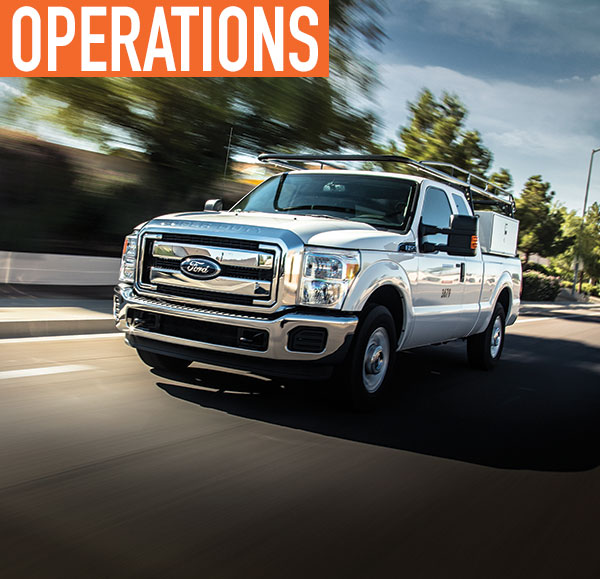Oftentimes, numbers tell a story.
For example, take the more than 14,000 propane autogas fleet vehicles added to roadways in 2016—an eight percent increase from 2015. The story behind that statistic is pretty clear: More fleet owners are choosing propane autogas to fuel their work vehicles.
When it comes to propane autogas in the work truck space, there are a lot of numbers—figures, statistics, percentages—that, when compiled in one place, tell the story of a fuel with many benefits that make operating a vehicle fleet more affordable, efficient, and environmentally sound.
The following is the story of propane autogas—by the numbers.
CONSIDER THE TREND
Propane autogas vehicle sales are trending upward. Take a look:
- Approximately 200,000 propane autogas fleet vehicles were registered in the US at the close of 2016.
- 14,000 light-, medium-, and heavy-duty vehicles were sold in 2016, according to data compiled by the Propane Education & Research Council (PERC). Light-duty vehicles made up 62 percent of those vehicle sales, compared to medium- and heavy-duty vehicles, which combined to make up the other 38 percent.
- Annual sales saw an eight percent increase from 2015 to 2016. The sales in 2016, in fact, accounted for the most vehicles sold in a single year since 2012.
- The number of propane autogas fleet vehicles on US roadways has increased by 35 percent in the past 12 years.
- 67 percent of all propane autogas vehicles currently on the road are certified conversions, compared to 33 percent of the vehicles that are propane-dedicated fuel systems.
- Data compiled by PERC forecasts an additional 79,000 propane autogas vehicles on the road by the year 2020.
COST CONSIDERATIONS
Depending on the current cost of fuel, some fleets have been able to recoup their initial investment in as little as two to three years—a fraction of the lifespan a work truck can have. A fleet can experience 30 to 50 percent savings per gallon with propane autogas compared to other fuels. For example, El Milagro, a tortilla products manufacturer based in Chicago, pays 50 percent less per gallon to fuel its bi-fuel Isuzu box trucks compared to its gasoline and diesel vehicles.
Plus, no additional fluids or filters are needed to operate a propane autogas vehicle. This is unlike a diesel engine, which has additional maintenance costs that should be taken into account when considering the total cost-of-ownership of a vehicle.

There are two refueling options that are most common for propane autogas vehicles, both of which help tailor a refueling strategy to meet a fleet’s financial needs or growth demands. The first option is a private, on-site refueling station, which can be scaled to grow with the fleet. The other is a public or private refueling network, which doesn’t require any infrastructure investment and can benefit small-budget fleets with limited space or fleets needing more fueling locations along their routes.
And, consider this: PERC’s Quick-Connect Nozzle Incentive program for a hose-end connector offers $1,000. Private fleets and public refueling stations are eligible to apply for the incentive program, which also offers $100 per tank-side connector. Refueling with quick-connect nozzles mirrors the experience of filling up with traditional fuels, making it simple to transition operators to propane autogas vehicles. The incentive is available for fleets wanting to upgrade their refueling equipment.
FEWER EMISSIONS
Propane autogas is not only good for fleets, it’s a good for the community. Fewer emissions means a smaller environmental footprint:
- Medium-duty vehicles emit 27 percent fewer greenhouse gases than gasoline models, while light-duty vehicles emit 14 percent fewer greenhouse gases than gasoline models.
- Light-duty vehicles emit 57 percent fewer smog-producing NOx emissions than diesel models and six percent fewer than gasoline. Medium-duty propane autogas vehicles produce 31 and 18 percent fewer NOx emissions than gasoline and diesel vehicles, respectively. One example, Children’s Hospital, was able to reduce its particulate emissions by between 30 to 40 percent in its employee shuttle program.
- The program uses bi-fuel shuttles to reduce the number of employees commuting by car.
- There is zero risk for operators of smelling like fuel at the end of the day. Propane autogas is odorless, except for an odorant added to help detect leaks, and won’t stay on shoes or clothing. This can increase driver satisfaction, along with propane autogas’ quieter engines and cleaner exhaust, all of which can create a better operating environment for drivers.
- Approximately 90 percent of propane supplies are produced in the United States, which supports the economy, American jobs, and energy security.

Any way these numbers are grouped, they collectively tell the story of propane autogas work vehicles. Propane autogas can offer a lower total cost-of-ownership for fleet owners and a better experience for service technicians, drivers, community, and the environment.
ABOUT THE AUTHOR:
Michael Taylor is the director of autogas business development at the Propane Education & Research Council. He can be contacted at michael.taylor@propane.com.
_______________________________________________________________________
MODERN WORKTRUCK SOLUTIONS: JUNE 2017 ISSUE
Did you enjoy this article?
Subscribe to the FREE Digital Edition of Modern WorkTruck Solutions magazine.
![]()




